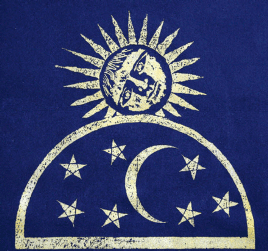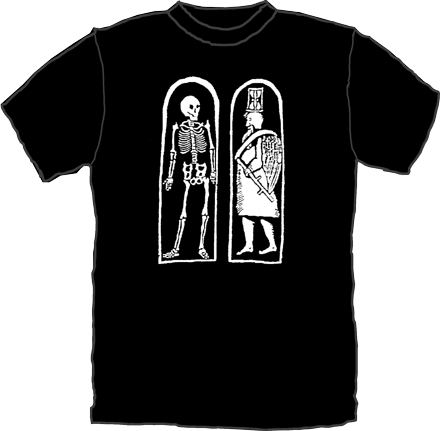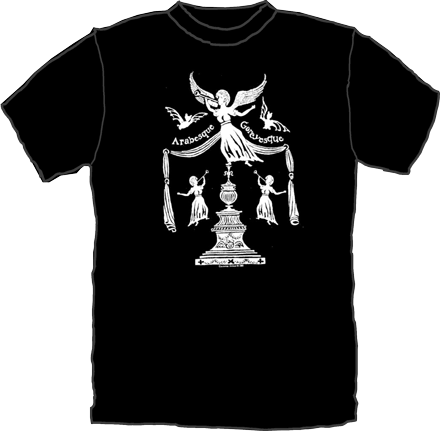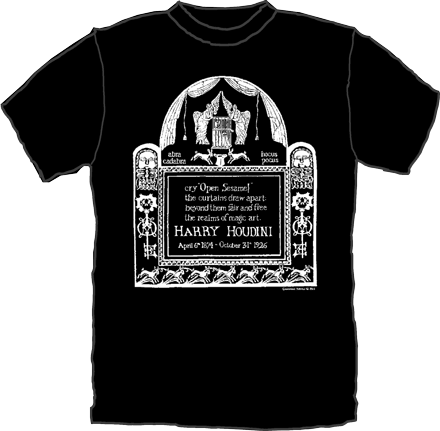
This site along with our sister site Gravestone Rubbing Supplies is dedicated to our customers who have been purchasing our products since 1992. We owe our business success to all of you. You have inspired us to keep searching for new designs to add to our product collection. And because you continue to purchase our products, you have helped us set the high standards of quality and customer satisfaction that is “set in stone” as part of our business philosophy.
Did you know that early new England burying grounds were the first public art galleries in the new World? Even today, many of these verdant, tranquil sites contain a remarkable progression of the artistic, cultural and religious history of the region. Often, old gravestones explain how an entire family lived and died. Neglect, natural aging, and vandalism, unfortunately, have resulted in the destruction of some of the finest examples of the early stone carving, and numerous old cemeteries are closed to the public to protect the remaining stones.
Trough careful hand-rubbing on special paper, Gravestone Artwear® has preserved hundreds of images representing the evolution of the early stone carver’s art from 17th century symbols to the more sophisticated and artistic tableaux of the 19th century. This catalog illustrates the depictions of 17th through 19th century gravestone carvings from New England, ancient Celtic designs from Ireland, and medieval brass rubbings from England.
At our York Village, Maine, studio, these beautiful images are made into silk screens and meticulously printed onto t-shirts and a collection of velvet garments and accessories. Hang tags describe the designs, their origins, and detail the symbolism used by the stone carvers.
** Featured in: The Boston Globe, Yankee Magazine, Down East Magazine, the Portland Press Herald, TWA’s Ambassador, The Portsmouth Herald, Fosters Daily Democrat, The New Age Retailer, WCSH-TV

Each and every American has his or her own memory of flags flying, bands playing, parades, fireworks, all in celebration of our great Independence Day holiday, the 4th of July. One of the most notable 4th of July celebrations takes place in Bristol, Rhode Island, each year. Since 1785 the town of Bristol has hosted the oldest continuous 4th of July celebration in the United States. This year will be its 226th celebration.
No doubt there will be many American flags flying over the streets of Bristol. And they will represent the glory and sacrifices that have made our country great. When you fly your great American flag, remember that it needs to be in proper condition, no tatters or rips. When carried in a color guard, it should be centered in front of the others and held higher than any others. Displayed from a pole, the flag is flown at the top of the pole unless it is flown at half-mast. At half-mast, it is carried to the top of the pole and then lowered to half-mast position. When taking it down, it is raised to the top and then lowered all the way down. On the Fourth of July, it is flown in all its glory, on top of a pole. Without a pole to mount your flag, it should be attached to your car or your house by its right front corner.
In York, Maine, the home of Gravestone Artwear®, Flags Over Maine Streets unifies this community by flying flags on utility poles over its Maine Streets during special holidays. Michael Little, founder of this grass roots organization to honor his son, Army Specialist Kyle A. Little who was killed by a roadside bomb during his second tour in Iraq in May of 2007, started this commitment to honor his son. His goal is to have an American flag flying from every utility pole on every street in the town of York on Armed Forces Day, Memorial Day, Flag Day, Fourth of July and Labor Day. Now a nonprofit organization with its own web site, Flags Over Maine Streets, continues to add more flags every year to make York, Maine, a town truly proud of its heritage and committed to honoring those who gave their lives for our country.
Gravestone Artwear® is proud to support Flags Over Maine Streets. Please check out its website at : https://www.flagsovermainestreets.com/
In York, Maine, the home of Gravestone Artwear®, Flags Over Maine Streets unifies this community by flying flags on utility poles over its Maine Streets during special holidays.
Participate in your own great neighborhood event…...and the parade marches on…...

Of course the neighborhood favorite four legged critter,

We have many a different hat…..

along with many different forms of transportation,

and to end all a custom Red, White & Blue scooter ! “Everyone” enjoys a good 4th of July Parade
The Kalaupapa National Historical Park Service on the Island of Molokai, Hawaii, is using our Gravestone Artwear® Rubbing Supplies to Record History.
Between the years 1866 - 1948 an estimated 8,000 people, mostly native Hawaiians, were forcibly taken from their families and sent to the Kalaupapa Peninsula because they were believed to have had leprosy, now officially named Hansen’s Disease. Since there were no antibiotics in the 19th century, isolation was thought to be the best solution to deal with this contagious disease. The first group of 12 people arrived on January 6, 1866, and consisted of nine men and 3 women. They were accompanied by 4 family members who were designed as helpers.
The Kalaupapa National Historical Park is located on the island of Molokai in the State of Hawaii and was designated a national historic landmark on January 7, 1976, to honor and perpetuate the memory of those individuals who were forcibly relocated to the Kalaupapa Peninsula.

It’s most outstanding citizen of this colony was Father Damien deVeuter who arrived at Kalaupapa in 1873 and lovingly served the leprosy patients for 16 years until his death from the disease in 1889. He was canonized a saint on Oct. 12, 2009, by Pope Benedict XVI and is buried in the graveyard adjoining St. Philomena’s Catholic Church, one of two churches on the island. Mother Marianne Cope who devoted her religious life to care for women and children leprosy patients will be canonized as a saint by Pope Benedict XVI on October 21, 2012.
There are two cemeteries on the island which include many unmarked graves as well as monuments and markers to respect the victims of Kalaupapa tragedy. Our Aqaba rubbing paper and gravestone rubbing wax are being used under the supervision of Ka’ohulani McGuire, Cultural Anthropologist, to record all the information found on markers in these cemeteries for posterity.
Visitors are welcome to visit this beautiful remote island. Access to the island is limited to airplane or boat ride. Once there walking and mule ride are the best means of transportation.
Please visit the Kalaupapa National Historical Park site at https://www.nps.gov/kala/index.htm to read about its plans to commemorate a memorial to the Kalaupapa patients.
The famine and refugee crisis in Africa continues. All of you who purchased Gravestone Artwear® t-shirts this fall helped us donate 10 percent of each sale during the months of September and October to CARE International to help support its humanitarian efforts to fight poverty. A Gravestone Artwear® check in the amount of $300 has been sent to CARE to help bring relief to the more than 13 million people in the Horn of Africa who are in urgent need of lifesaving humanitarian assistance, including woman, children and the elderly in Ethiopia, Kenya, Somalia. Thank you all for helping to support CARE in its efforts to improve the lives of the world’s poor.
For more information about how you can help,
Please visit CARE’s website: https://www.CARE.org/

The 34th annual conference of the Association for Gravestone Studies (AGS) was held at Colby College, Waterville, Maine, June 14 19th. There were lectures, workshops, exhibits, tours of Maine cemeteries and even sales tables something for everyone interested in gravestone studies.
Lecture topics presented included Lynne Baggets Incised Letterform. As demonstrated by Lynne, through careful examination of carved lettering, a stonemason can be identified and his heritage revealed. She also takes this process one step further and creates the most interesting art forms from lettering found on graves and other resources. Even her cast forms taken from contemporary sign lettering have their roots in the ancient carvings.
Always, these lectures and workshops display our cultural heritage and our connections to ancient, medieval, colonial and Victorian influences when it comes to gravestone art and the men and women who carved the stones.
Other papers were presented on topics ranging from images of turn-of-the century Maine; rare Jewish cemetery monuments; portrait gravestones, finger pointing hand carved gravestones of the 19th Century; sandstone markers in Tuscaloosa, Alabama, cemeteries; grave structures in Louisiana and other parts of the South; Yellow Fever Epidemics; Old Dutch Cemeteries, and even a lecture on the allegorical death scene in which an angel guides a soul on the last voyage across water to a distant land. All of these lectures required a great deal of research by each presenter and inspire further study into each topic.
The most noteworthy hands-on two-day workshop during this conference is the Conservation workshop. Its hard work and involves the participants in learning the proper techniques for cleaning, repairing, resetting stones and mortaring them into a base. And thats the Beginner Workshop. That workshop is followed-up by a full day advanced workshop which includes learning how to assess and document gravestones and monuments, use a consumer grade handheld GPS, advanced cleaning techniques, core drilling and removing rusted, damaged pins, adhesive repair of stone fragments and the use of various mortars for infills and replacement of lost materials. WOW! These workshops teach Association for Gravestone Studies participants conservation and restoration skills and they in turn use these skills to work in their favorite burying grounds and cemeteries to restore damaged markers, gravestones and of course monuments.
Other workshops included letter form casting; photography; making foil impressions of gravestones; paranormal experiences; understanding the history and evolution of cemetery markers; gravestone rubbing; and even humor in the graveyard.
The next AGS conference will be in June of 2012 at Monmouth University, West Long Branch, New Jersey. Please contact the Association for Gravestone Studies in Greenfield, Massachusetts, for more details. Its web site is: https://gravestonestudies.org/
(Please scroll down to see the Gallery from our travels while we attended the conference)
Here are photos of AGS conferees wearing Gravestone Artwear® t-shirts.
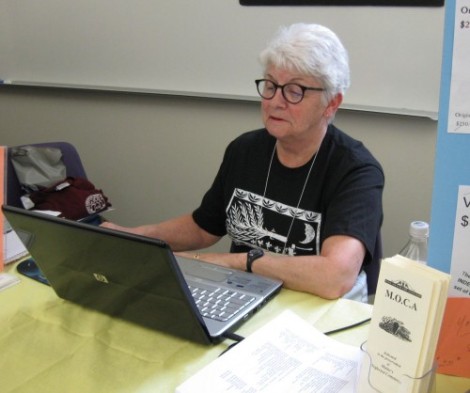




The above shows details from a Celtic Cross found in the Mount Pleasant Catholic Cemetery in Bangor, Maine

Several marble gravestones and the ~Death House~ in the background at Mount Pleasant Catholic Cemetery in Bangor, Maine. **Note: In most New England cemeteries, the Receiving House or Death House as it is called in Bangor, Maine, is the place where the deceased were kept until spring when the ground thawed enough to enable proper burying of the deceased.

A close up of the beautiful wreath of glass beads.

The Annie and Captain J. French memorial at the Mount Hope Cemetery in Bangor, Maine. This is America’s second garden cemetery, designed by Charles G Bryant in 1834. The first garden cemetery is Mt. Auburn Cemetery in Cambridge, Massachusetts. This above photo is the stylish monument which Annie French patented and included the beautiful wreath.

These stones steps at Mt Hope Cemetery were photographed during the funeral scene in Stephen King’s movie, Pet Semetary. For those of us who have seen the movie, Stephen King even made a cameo appearance as the minister who officiated at the funeral of Missy Dandridge.

This beautiful building with its ornate ironwork was a departure and arrival station house for visitors to and from the cemetery by streetcar in the late 19th and early 20th century. **Note: The Mount Hope Cemetery, Bangor, Maine, one of America’s most beautiful rural garden cemeteries encompasses over 250 acres. The cemetery includes the grave sites of Hannibal Hamlin, Abraham Lincoln’s Vice President. Other notables are two U.S. Senators, eleven U.S. Congressmen, two U.S. Ambassadors, five Maine Governors, eight Civil War Generals and numerous others.

And what trip to Bangor, Maine, would not be complete without a drive-by past Stephen King’s house. Shhhh, we’ll never tell you exactly where it is so you can appreciate this lovely facade and especially the unique gate from the photo we snapped. After all, this is what we would expect Stephen’s King’s house to look like. Right?

The Early New England Burying grounds were the FIRST public Art Galleries of the New World, Even today, many of these verdant, tranquil sites contain a remarkable progression of the artistic, cultural, and religious history of the region.Often old Gravestone’s explain how an ENTIRE family lived and died.Neglect, natural, aging, vandalism. Unfortunately, have resulted in the destruction of some of the finest examples of early stone carving, and numerous old cemeteries are closed to the public to protect the remaining stones.
© Copyright Gravestone Artwear®. All Rights Reserved.







